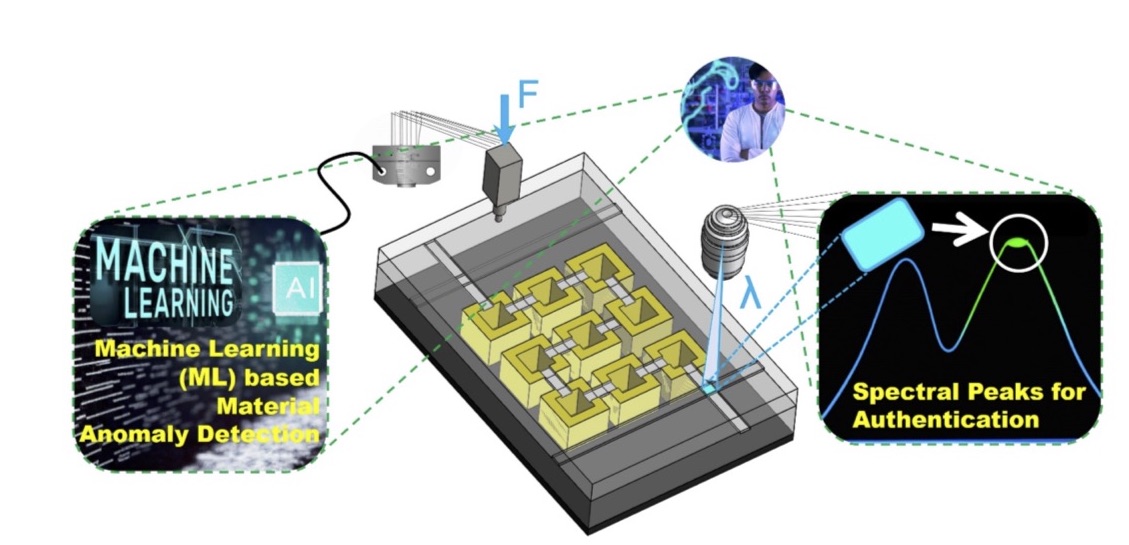Figure Caption: An illustration of two countermeasures to address material-level attacks on microfluidic biochips. On the left, an ML-based material authentication scheme where a simple punch test (F), coupled with a load cell, can authenticate whether the material’s composition is correct. On the right, a laser shining UV light (λ) on the dye-doped microvalve, provides a spectral signature with peaks that dynamically change based on the mechanical deformation of the valve.
A research paper written by Navajit Singh Baban, currently a postdoctoral associate at the Center for Cyber Security at NYU Abu Dhabi, was recently selected as the cover story for the August 2023 issue of Lab on a Chip, a journal of the Royal Society of Chemistry ). The paper, entitled “Material-Level Countermeasures for Securing Microfluidic Biochips”, documents his research efforts to protect the use of microfluidic biochips (MBs), or devices that “miniaturize and integrate various laboratory processes onto a single platform.”
Baban conducted this research as part of the Abu Dhabi Collaborative Grant Program, which brought him and six other post-doctoral researchers to NYU sites in Brooklyn and Manhattan from July 9 to 29 to work alongside outstanding NYU researchers. During his time at Tandon, Baban collaborated with Drs. Ramesh Karri and Nikhil Gupta, full professors in electrical and computer engineering and mechanical and aerospace engineering, respectively, to complete what he described as “a comprehensive exploration of potential vulnerabilities and attack vectors associated with MBs.”
The topic selection was a timely one as medical devices and equipment have become an increasingly desirable attack surface for hackers. According to the FBI’s Internet Crime Report for 2022, 210 of a total of 2,385 reported ransomware attacks that year were directed against hospitals and public health care organizations. Specifically, as Baban explains, attacks on MBs can “imperil patient well-being, erode trust, squander resources, and trigger economic consequences,” and therefore calls for “swift, coordinated countermeasures” to “maintain biochips’ reliability, confidentiality, and trustworthiness.”
His research initiative began with benchtop experiments to empirically demonstrate the types of potential attacks. With the knowledge gained from these experiments, the project focused on “devising effective countermeasures.” These defensive strategies include a suite of resources capable of safeguarding MBs from threats like “manipulation of bioassay outcomes, tampering with biomolecular protocols, denial-of-service disruptions, intellectual property theft, and biopiracy, among other perils.”
According to Baban, the paper documents how “the mechanical performance of MBs could degrade if reactive or deteriorating chemicals were intentionally introduced during fabrication.” His team developed a “machine learning-based method capable of detecting doped materials using a simple punch test combined with a force sensor, an approach that achieved an accuracy rate of over 99% in identifying material-level anomalies.” The research team also developed “a dynamic watermarking scheme using a mechanoresponsive dye,” that enabled “a spectral signature change under ultraviolet laser exposure.” This watermark makes MBs resistant to reverse engineering attempts.
The research initiative was funded by the National Science Foundation, with Dr. Karri and Krishnendu Chakrabarty, Fulton Professor of Microelectronics from Arizona State University serving as principal investigators on the grant. Other collaborators included researchers from Duke University in Durham, NC, and the Indian Institute of Technology in Guwahati, India. Credit also goes to Ross Fleming, Senior Assistant Director for Graduate and Post-doctoral Support, who played a key role in bringing Baban and his colleagues to New York.
